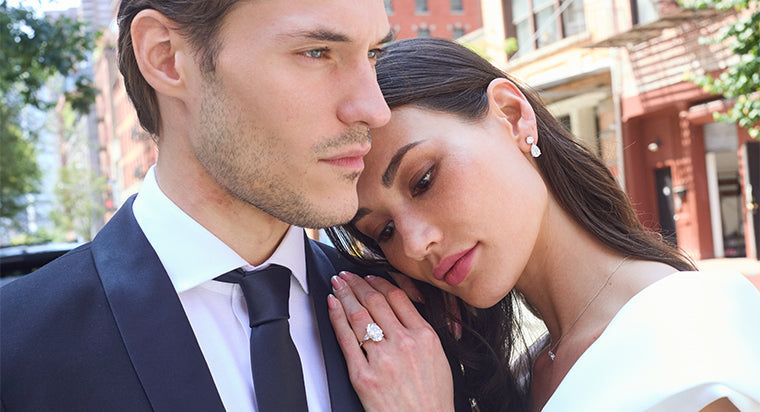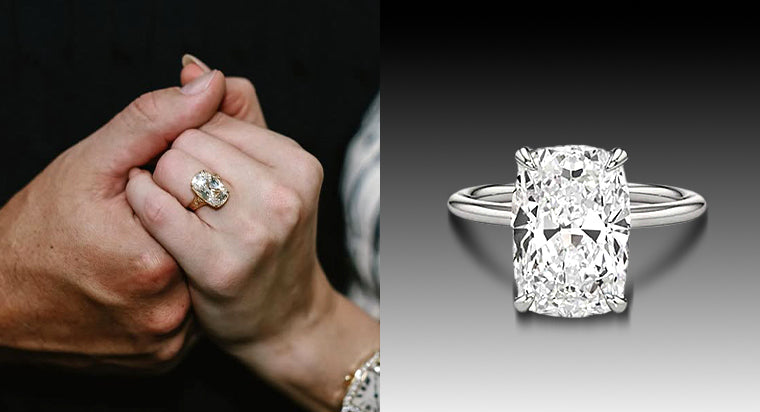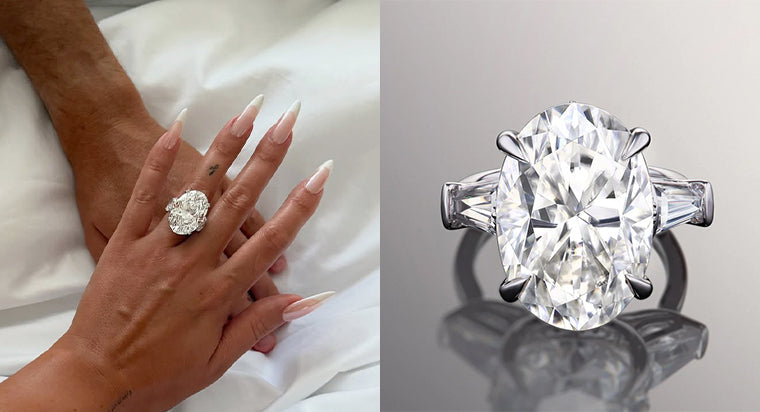Thinking Of a 1 Carat Diamond Ring? We Answered All of Your Potential Questions

When it comes to diamond rings, many people assume that bigger automatically means better. But that’s not always true. Opting for a 1 carat diamond ring is often the best choice for most couples — both in price and practicality.
Even better: It’s a classic, timeless style that’ll never go out of fashion.
TABLE OF CONTENTS
What Does a 1 Carat Diamond Ring Look Like?
No two couples are alike — and the same goes for the 1 carat diamond ring they use to symbolize their union. Diamonds are typically measured in 1 carat increments. The problem: Most of us don’t really know what that means, other than that a 1 carat diamond ring is smaller than a 2 carat diamond ring — and so on.
A carat is simply a unit of measurement that refers to the weight of the diamond, not the shape. 1 carat equals 0.2 grams, or 200 milligrams — about the size of quarter piece of Chiclets gum.
The actual look of a 1 carat diamond ring depends on a number of factors, including:
- The way the diamond is cut
- How the diamond is set in a ring
- If there are other gemstones set around the diamond
- The clarity of the diamond

How to Make Your 1 Carat Diamond Ring Look Bigger
Opting for a 1 carat diamond ring gives you the flexibility to really make it look unique. Because the diamond isn’t the overwhelming focal point. However, you can get more bang for your bling by using a few tricks.
Look for “excellent” stones. The Gem Institute of America has a grading system that rates diamonds by a number of factors, including the cut. Diamond cuts fall under one of four categories under this system: excellent, very good, good, and fair.
A 1 carat diamond ring with an “excellent” score has better cuts and angles — and will shine more brightly — than other diamonds, making it look bigger to the naked eye.

Opt for fancier shapes. Circle diamonds aren’t cut as deep, making them look bigger on the surface. More oblong cuts — like oval, emerald or marquise — can give the impression that the diamond is bigger than its actual weight.
Avoid cushion-cut diamonds. Cushion-cut diamonds are deep set, meaning that a lot of the weight is under the surface and is less visible than other cuts.
Consider colored diamonds. Soft pink, yellow, blue, or green diamonds tend to look bigger than they actually are.
Choose a platinum band. Going for a platinum band on your 1 carat diamond ring can help the stone look larger. The reason: the white color reflects the diamond, giving it a larger look.
Choose a thin metal band. A thinner band makes the diamond look bigger by comparison. The opposite is true for a large band, too.
Go for a halo ring setting. Setting your one-carat diamond ring in a halo style is an effective way to make it look significantly bigger. A halo setting is a style that includes the center gemstone — the diamond — surrounded by a ring of pavé or micro-pavé diamonds.

The added pavé stones make the center diamond look bigger and reflect more light, drawing people to look at the ring.
Don’t go for a bezel setting. A bezel is a type of elongated setting on a ring that completely surrounds the diamond in the metal edging (as shown below). This style emphasizes the shape of the diamond inside — and there aren’t any accent stones to make it appear bigger.
Instead, go for more slender (or fewer) prongs to hold the diamond in place. This helps maximize how much of the diamond’s surface shows — and makes it look as big as possible.
How Much is a 1 Carat Diamond Ring?
The price of a 1 carat diamond ring — like all diamond rings — depends on the balance of the 4 C’s: color, clarity, carat, and cut.
Diamond Ring Price Factors: Carat Weight
The weight of a diamond also plays into the price. Though the cost of a 2-carat diamond ring isn’t necessarily double that of a 1-carat ring. Instead, one of the most important factors in the cost is the shape of the diamond. The reason: More intricate shapes can take longer to cut than others, driving up the price.
The most expensive diamond shapes
Round diamonds are typically the most expensive shape, followed by cushion shape and princess shape diamonds. The good news: Some oblong shapes – like ovals and emeralds — aren’t as expensive. Therefore they can be a more economical option when buying a 1 carat diamond ring.
Diamond Ring Price Factors: Color
Pricing is also affected by the color of the diamond. White diamonds tend to be more expensive with less color because they’re considered to have better clarity (no knicks/ impurities). The GIA and IGI scale for white diamonds goes from D-Z, with D being the most valuable — and the most expensive.
Black, red, blue, green, and other colored diamonds are typically more expensive than even the most flawless white diamond. The reason: They’re rarer, so it drives up the price.
Lab Created vs Natural Diamonds
Sparkly as they come, and similar as they look and feel, there are vast differences between lab grown diamonds and natural diamonds and it is essential that you know the difference before deciding to invest in one.
If you are one to support environmental sustainability, you could opt for a 1 carat lab created diamond as it takes lesser energy to “create” diamonds in a lab than mine it from the earth. A 1 carat lab created diamond will also cost less than that of a same-sized natural diamond with the same quality specifications. A Lab created diamond also has a known origin so you know where your sparkle is coming from as compared to a natural diamond. But that doesn’t mean that one is better than the other. Lab grown diamonds and natural diamonds have the same physical and chemical properties.
Differences in Certification
But having said that, both have different certifications as you must already know. In the case of lab grown diamonds, an IGI (International Gemological Institute) certification works best as they follow strict international standards. They share the key points of the diamonds in an informative way to help you to assess the diamond thoroughly. An IGI certification is a great choice and also looks for important parameters like cut, color, clarity, and carat weight amongst others.
If you are looking specifically for a GIA (Gemological Institute Of America) certification, you may want to get yourself a natural diamond. GIA is one of the most trusted and respected diamond grading entities in the world and is known for consistency and strict valuation parameters to take the stress out of buying a diamond. Confidence is quintessential when investing in a diamond and GIA thoroughly evaluates a diamond on a variety of qualities and elements including carat weight, table, depth, symmetry, polish grade, and proportion amongst others.
Choosing Between a Lab Grown & Natural Diamond
Despite all the similarities, there is a growing gap in price, resale value, and overall desire and purchasing capabilities for lab-created diamonds vs. natural diamonds. Natural diamonds have a limited supply as it may take over a million years for nature to play its part and make a diamond. But with a lab grown diamond that is “made” rather quickly, the supply is unlimited which in turn offers a great price range for the same size of a diamond. The difference in the resale value between the two is another point to note while making a decision. It usually is even greater than the price difference we have discussed ever so often. While natural diamonds may retain about 50% of their original value, that can differ for lab grown diamonds with time.
Other Things to Consider
While there isn’t a one-size-fits-all price for a 1 carat diamond ring, you can find the right one for you — and your ring budget — by deciding which of the 4 Cs of diamonds is most important to you. If you have your heart set on a 1 carat diamond ring, consider opting for a gemstone that has less clarity (or cut in a less expensive shape).
Even better: Enlist the help of an expert gemologist. Ours are accessible through chat, email, or phone. Contact us by phone at 1(844)-234-6463 or email at service@withclarity.com. Our Live Chat is available during business hours Monday - Friday, 10 AM - 5:30 PM ET. Your gemologist can take your wishes — and your budget — into consideration to find the best 1 carat diamond ring that can turn your dreams into reality for a reasonable price.










